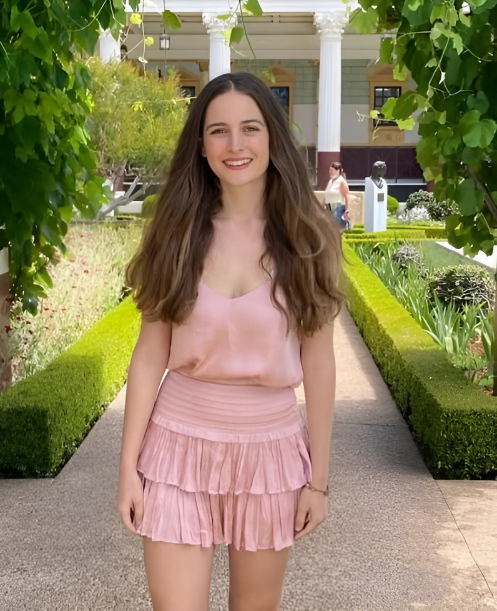Fourth-Year AuD student Aspen Bombardo Champions Bridging Passions

For fourth-year Doctor of Audiology (AuD) student Aspen Bombardo, the path to pediatric audiology started with a love of learning languages and a passion for working with kids. Full of ambition and an eagerness to bridge her interests, Aspen went on a potential career deep-dive before finally finding the field of hearing and speech sciences, the perfect combination of working on language development skills with children in a clinical setting. By the time she headed to college, she had decided to major in Communication Sciences and Disorders at Boston University, her career plan laid out in front of her, or so she thought.
“I came in thinking I’d pursue speech pathology, but I ended up just really enjoying the audiology coursework,” she said. “Through one of the school’s faculty members, I got to work as a newborn hearing screener in college, and that was sort of my introduction to audiology. I fell in love with it that way, and that’s how I ended up at Vanderbilt.”
When considering where she wanted to pursue her graduate studies, the opportunity to do hands-on training with pediatric patients was at the forefront of her criteria. Vanderbilt’s program stood out. With its specialized pediatrics track and immediate opportunities for clinical work, particularly at Vanderbilt’s renowned Monroe Carell Jr. Children’s Hospital, Vanderbilt’s Doctor of Audiology program provided everything Aspen wanted to shape her career.

Aspen’s time at Vanderbilt both furthered her love for pediatric audiology and led her to discover a second love: vestibular science, or the study of balance and spatial orientation. Initially, Aspen assumed she would have to choose between pediatrics and vestibular work, two areas of focus that don’t traditionally overlap. But with encouragement from her mentor, Assistant Professor Dr. Daniel Romero, she realized there was an opportunity to bridge both fields and step into a critically under-researched space.
“I told Dr. Romero I had this interest in vestibular during my second year but also that I was a peds person, so I couldn’t really do vestibular work,” she said. “He responded with, ‘Well, actually, you can,’ and let me know that there is a really exciting pediatric vestibular research scene emerging. He followed up by suggesting a potential pediatric vestibular capstone project, and from there helped me put it all together.”
For her capstone research project, Aspen investigated a method for vestibular screening in infants by adapting a clinical test known as the cervical vestibular evoked myogenic potential (cVEMP). Working primarily with babies being evaluated for hearing concerns at Monroe Carell Jr. Children’s Hospital, she analyzed how infant vestibular responses compared to those of adults, seeking early markers of balance system function.
“So, what we do is we put electrodes on the neck, and we’re actually able to measure response when we stimulate the saccule, one of five vestibular end organs within the ear, using a loud sound that we play within the ear,” she explained. “That’s what I was doing with babies. I was putting electrode stickers on their faces and necks, and then I would play the sound, do silly things, or play videos to get them to turn their head. Then I measured their responses and compared them to those of adults to see one, are we getting a present response in most of the babies that we test, and two, what that response looks like in terms of how big it is and when it occurs.”

Beyond her research, Aspen continued to broaden her clinical skills. One of the most transformative experiences of her training came in 2023, when she traveled to Krakow, Poland, with Vanderbilt faculty and peers to provide vestibular and hearing screenings for Ukrainian refugees. Though incredibly rewarding, the opportunity did not come without hurdles; vestibular testing typically requires advanced technology, which cannot be transported overseas. This situation led Aspen and her peers to problem-solve in order to provide meaningful care.
“We had to learn how to do a lot of the testing with limited equipment, using our hands or simulating things, for example, an uneven surface with a foam pillow, just kind of making do with things,” she explained. “It was a really unique experience to provide care that’s already pretty limited within the US to people who wouldn’t have otherwise have access to it.”
Back in Nashville, Aspen completed her fourth-year externship at Vanderbilt University Medical Center, splitting time between balance and pediatric audiology clinics and caring directly for those with dizziness and hearing loss. The experience only confirmed her passion for both pediatric and vestibular audiology, but she remained skeptical that she would be able to find a post-graduate position that bridged her interests. Fortunately, much like when Dr. Romero had provided her the unique opportunity to follow her research dreams, Aspen also received the chance to pursue her dream job: a position as a pediatric audiologist at Rady Children’s Hospital in San Diego, where she’ll be focusing on pediatric balance and hearing aids.
As she reflects on her journey, Aspen has a few pieces of advice for students beginning theirs.
“Be open minded to everything,” she said. “Immerse yourself in every opportunity and talk to people about their work. Everyone is doing such interesting things and there’s so much to learn from them, be there and soak it all in.”
Leave a Response